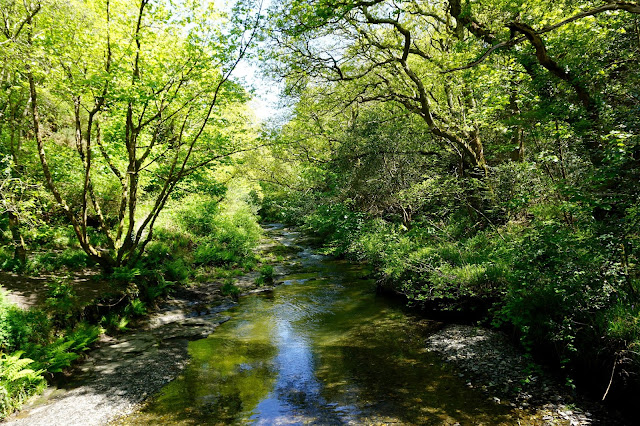With Tintagel as our base camp, we first headed about 5 miles north to Boscastle, a tiny port with a natural harbor, set in a gentle valley. The village has winding roads, thatched-roof and white-washed cottages, and an interesting natural harbor. Be sure to stop at the National Trust visitor's center for information on the many walks you can take from the harbor.
From the harbor we walked a lovely path that follows along the stream that feeds into the harbor, leads through fields and woods and past several tucked-away churches, then up to the top of the valley and back down to the village.
We also walked out to a blow hole not far from the harbor but the sea was so calm on that day that there were no waves and so, no blowhole.
From Boscastle we headed south, past Tintagel, to Port Isaac.
Port Isaac is a fishing village best known now as the film site of the British series Doc Martin staring Martin Clunes. Before it became famous it has been a fishing village since the early fourteenth century. It's naturally sheltered harbor, narrow winding streets, and old white-washed cottages and traditional granite, slate-fronted Cornish houses, make it truly picturesque and film worthy. It is easy to see why it was chosen as the site of the beloved TV series.
We were there at low tide so most of the boats were out of the harbor. As such, it made for great tide pools.
While we walked about the village, we saw this notice posted here and there and wondered what was being filmed.
It turns out they were filming a video of a local band called Fisherman's Friends. This day the filming was taking place a few hundred yards out to sea, not in the village.
From Port Isaac, we walked the Coastal path south to Port Quinn, a magical near-deserted cove with another rugged natural harbor.
From our guide book: "Local legend tells that the village (Port Quin) has been abandoned by its population twice in its history. The first time when the pilchard shoals deserted this part of the coast and the second time, in the 19th century, when all the local fishermen were lost at sea in a terrible storm leaving 32 women widowed. The wives of the fisherman stayed for a time but were unable to eke out a living and finally moved away. There is little documentation about the desertion of the village. The villagers may have just moved on to nearby villages when mining and fishing went into decline and some of them may have emigrated to Canada but no ones knows exactly what happened. Local people still refer to Port Quin as "the village that died".
We stayed at the Penallick B & B, about a mile south of Tintagel and only 200 yards off the Coastal path. It was clean, quiet, friendly, and the perfect home base for three days of walking this beautiful coastline.
Along the coastal walk between TIntagel and Port Isaac, we saw a number of old slate quarry mines. Slate quarrying began here probably in the late 1400's and the last of the mines closed in 1937. There are also remains and scars of old tin mines, although most of these are further south along the coast.
Thirty years ago, my parents spent several weeks, spread out over three trips, walking most of the Cornwall Coastal Trail. I had heard their stories, over the years, of the beauty of this land and coast, the quaintness of the villages and ports, and the friendliness of the people of Cornwall. I can now vouch that it is all true. It really is a spectacular coast line with amazing trails that cover most of the coast. It is one of our favorite spots in England. I can't wait to return and explore more of the coastal path.
For more information:
Boscastle National Trust
Port Quin National Trust
Port Quin Beach
Port Isaac Essential Guide
Doc Martin's Favorite Spots
P.S. Of the wildlife we saw on the trail, my favorite were the dogs. There were so many happy dogs. It's truly a walker's and dog lover's paradise.
P.P.S This is proof that occasionally my husband does take a picture. Only very occasionally, though.
























No comments:
Post a Comment